Part Two: Hazardous Earth Processes
Lab 6 Reading: Earthquakes
Earthquakes
Randa Harris
INTRODUCTION
It was the deadliest day in the history of Mt. Everest. On April 25, 2015, a 7.8 magnitude earthquake hit Nepal. This triggered an avalanche that killed 19 climbers on Mt. Everest. In Nepal, over 8,800 people died, and many more were injured and made homeless. Hundreds of aftershocks (smaller earthquakes that follow a larger earthquake) have occurred since (Figure 13.1).
Earthquakes are not new to this region. A similar death toll was experienced in a 1934 earthquake, and many other smaller earthquakes have occurred within historical times. An 1833 quake of similar magnitude resulted in less than 500 deaths, though this was most likely due to two very large foreshocks (smaller earth- quakes that precede the main earthquake) that sent most residents out of doors in alarm, which was safer for them. Worldwide, there have been much deadlier and stronger earthquakes just in this century (Haiti, 2010 – 316,000 dead; Sumatra, 2004 – 227,000 dead, both with deaths related to ground shaking and the other hazards that were created by the earthquake). Earthquakes give geologists valuable information about the Earth, both the interior, as we learned about in the Earth’s In- terior chapter, and about conditions at the Earth’s surface (most earthquakes occur at plate boundaries, as we learned in the Plate Tectonics chapter, Figure 4.8).

Figure 13.1 | A map of the main earthquake to hit Nepal on April 25, 2015, along with a major aftershock on May 12, and numerous (>100) other aftershocks (in red – note the magnitude scale in the upper right).
Author: USGS Source: USGS License: Public Domain
Learning Outcomes
After completing this chapter, you should be able to:
- Compare and contrast the different types of seismic waves
- Understand the different scales used to measure earthquakes, and apply them to the amount of devastation
- Understand how different geologic materials behave during an earthquake, and the resulting impact on structures
- Explain how an earthquake epicenter is located
- Explore the relationship between the fracking industry and seismicity
Key Terms
- Benioff Zones
- Body Waves
- Epicenter
- Focus
- Induced Seismicity
- Intensity
- Liquefaction
- Love Waves
- Magnitude
- P Waves
- Rayleigh Waves
- S Waves
- Seismogram
- Seismograph
- Seismology
- Surface Waves
THE EPICENTER, FOCUS, AND WAVES
An earthquake is a like a telegram from the Earth. It sends a message about the conditions beneath the Earth’s surface. The shaking or trembling experienced during an earthquake is the result of a rapid release of energy within the Earth, usually as a result of movement along geologic faults. Think back to the strike-slip fault from the Crustal Deformation chapter. Rocks on either side of the fault are sliding past each other. As they move in opposite directions, the rocks become deformed, as they will bend slightly and build up pressure. Eventually they will reach a breaking point. Once the strength of the rock has been exceeded, the rocks will snap back to their normal shape, releasing all that stored energy as an earthquake. The more energy that has been stored, the larger the earthquake is. Remember the stress-strain diagram from Crustal Deformation. When rocks are under too great of a stress, they undergo brittle failure (the earthquake). The strength of the rock has been exceeded at this point.
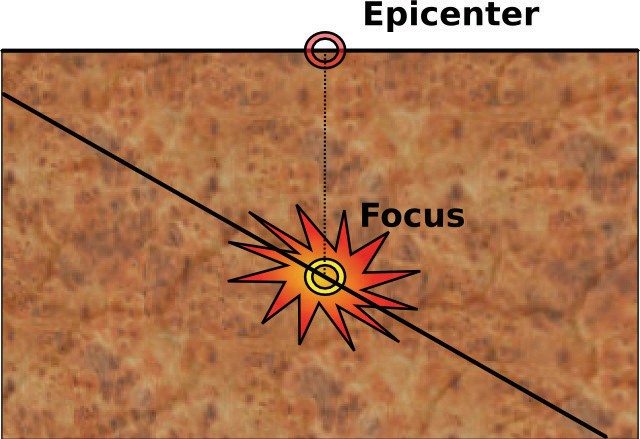
Figure 13.2 | An illustration depicting the focus, where the earthquake originates, and the epicenter, the point on the ground’s surface directly above the focus.
Author: Unknown Source: Wikimedia Commons License: GNU Free Documentation
Earthquakes originate at a point called the focus (plural foci). From this point, energy travels outward in different types of waves. The place on the Earth’s surface directly above the focus is called the epicenter (Figure 13.2). Earthquake foci may be shallow (less than 70 km from Earth’s surface) to deep (greater than 300 km deep), though shallow to intermediate depths are much more common. Earth- quake frequency and depth are related to plate boundaries. The vast majority (95%) of earthquakes occur along a plate boundary, with shallow focus earthquakes tending to occur at divergent and transform plate boundaries, and shallow to inter- mediate to deep focus earthquakes occurring at convergent boundaries (along the subducting plate). The earthquakes associated with convergent boundaries occur along Wadati-Benioff zones, or simply Benioff zones, areas of dipping seismicity along the subducting plate (Figure 13.3).

Figure 13.3 | This is a seismicity cross-section, taken along the subducting plate in an ocean-ocean convergent boundary at the Kuril Islands, located just northeast of Japan. Foci are located in the descending slab. Only brittle substances (like the lithosphere) can generate earthquakes, so this must be the subducting slab.The star represents the location of an 8.3 magnitude earthquake that occurred on 11/15/06.
Author: USGS Source: Wikimedia Commons License: Public Domain
As an earthquake occurs, two different types of waves are produced; body waves, so termed because they travel through the body of the Earth, and surface waves that travel along the Earth’s surface (Figure 13.4). There are two types of body waves. P-waves, or primary waves, are compressional waves that move back and forth, similar to the action of an accordion. As the wave passes, the atoms in the material it is travelling through are being compressed and stretched. Movement is compressional parallel to the direction of wave propagation, which makes P-waves the fastest of the seismic waves. These waves can travel through solids, liquids, and gases, because all materials can be compressed to some degree. S-waves, or secondary waves, are shear waves that move material in a direction perpendicular to the direction of travel. S-waves can only travel through solids, and are slower than P-waves. A similar motion to S-wave motion can be created by two people holding a rope, with one snapping the rope quickly. Alternately, you can also think of this wave movement similar to the wave created by fans in a stadium that stand up and sit down. Body waves are responsible for the jerking and shaking motions felt during an earthquake.
Surface waves are slower than body waves, and tend to produce more rolling sensations to those experiencing an earthquake, similar to being in a boat on the sea. Because surface waves are located at the ground’s surfacewhere humans (and their structures) are located, and because they move so slowly, which bunches them up and increases their amplitude, they are the most damaging of seismic waves. Love waves are the faster surface waves, and they move material back and forth in a horizontal plane that is perpendicular to the direction of wave travel (see Figure 13.4). Buildings do not handle this type of movement well, and Love waves may be responsible for considerable damage to structures. Rayleigh waves make the Earth’s surface move in an elliptical mo- tion, similar to the movement in a sea wave. This results in ground movement that is up and down and side-to-side.
SEISMOLOGY

Figure 13.4 | The different types of seismic waves. Body waves, in the upper portion of the figure, consist of P-waves and S-waves. The P-wave motion is compressional. The hammer on the left starts the wave moving. The arrow on the right shows the general direction of the wave. In the S-wave, the motion is undulating. Surface waves are depicted in the lower portion of the chart. Love waves move similarly to S-waves, resulting in horizontal shifting of the Earth’s surface. Rayleigh waves are surface waves that travel much like a wave along the water’s surface.
Author: USGS Source: Wikimedia Commons License: Public Domain
Earthquakes have been experienced by humans as long as humans have roamed the Earth, though most ancient cultures developed myths to explain them (including envisioning large creatures within the Earth that were moving to create the quake). The study of earthquakes, called seismology, began to take off with the development of instruments that can detect earthquakes; this instrument, called a seismograph, can measure the slightest of Earth’s vibrations (Figure 13.5). A typ- ical seismograph consists of a mass suspended on a string from a frame that moves as the Earth’s surface moves. A rotating drum is attached to the frame, and a pen attached to the mass, so that the relative motion is recorded in a seismogram. It is the frame (attached to the ground) that moves during an earthquake—the suspended mass generally stays still due to inertia (the tendency of a body to stay at rest and resist movement).
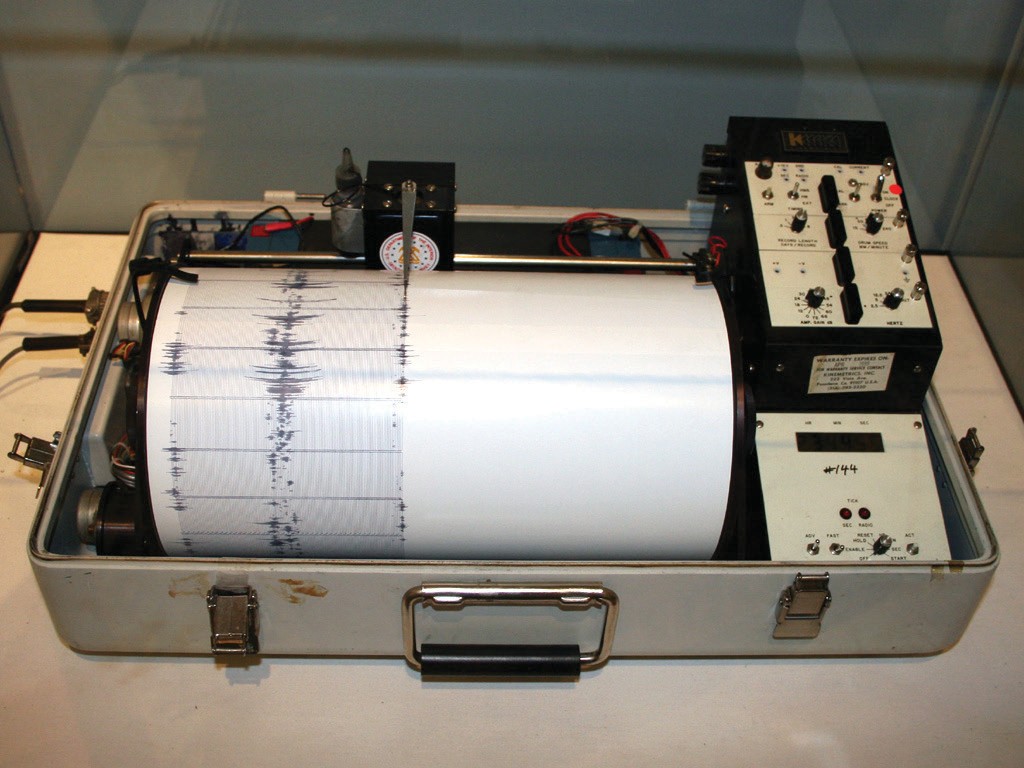
Figure 13.5 | A seismograph and the seismogram it produces.
Author: User “Yamaguchi” Source: Wikimedia Commons License: CC BY-SA 3.0
How Are Earthquakes Measured?
The tragic consequences of earthquakes can be measured in many ways, like death tolls or force of ground shaking. Two measures in particular are commonly used. One is a qualitative measure of the damage inflicted by the earthquake, and it is referred to as intensity. The second is a quantitative measure of the energy released by the earthquake, termed magnitude. Both measures provide meaningful data.
Earthquake Intensity
Intensity measurements take into account both the damage incurred due to the quake and the way that people respond to it. The Modified Mercalli Intensity Scale (Figure 13.6) is the most widely used scale to measure earthquake intensities. This scale has values that range from Roman numerals I to XII which char- acterize the damage observed and people’s reactions to it. Data for this scale is often collected right after an earthquake by having the local population answer questions about the damage they see and what happened during the quake. This information can then be pooled to create an intensity map, which creates colored zones based on the information collected (Figure 13.7). These maps are frequently used by the insurance industry.
|
Intensity |
Characteristics |
|
I |
Shaking not felt under normal circumstances. |
|
II |
Shaking felt only by those at rest, mostly along upper floors in buildings. |
|
III |
Weak shaking felt noticeably by people indoors. Many do not recognize this as an earthquake. Vibra- tions similar to a large vehicle passing by. |
|
IV |
Light shaking felt indoors by many, outside by few. At night, some were awakened. Dishes, doors, and windows disturbed; walls cracked. Sensation like heavy truck hitting a building. Cars rock noticeably. |
|
V |
Moderate shaking felt by most; many awakened. Some dishes and windows broken. Unstable objects overturned. |
|
VI |
Strong shaking felt by all, with many frightened. Heavy furniture may move, and plaster breaks. Dam- age is slight. |
|
VII |
Very strong shaking sends all outdoors. Well-designed buildings sustain minimal damage; slight-moderate damage in ordinary buildings; considerable damage in poorly built structures. |
|
VIII |
Severe shaking. Well-designed buildings sustain slight damage; considerable damage in ordinary build- ings; great damage in poorly built structures. |
|
IX |
Violent shaking. Well-designed buildings sustain considerable damage; buildings are shifted off foundations, with some partial collapse. Underground pipes are broken. |
|
X |
Extreme shaking. Some well-built wooden structures are destroyed; most masonry and frame structures are destroyed. Landslides considerable. |
|
XI |
Few structures are left standing. Bridges are destroyed, and large cracks open in the ground. |
|
XII |
Total damage. Objects thrown upward in the air. |
Figure 13.6 | An abbreviated table of the Modified Mercalli Intensity Scale. Intensity for a particular earthquake is determined by the maximum damage incurred.
Author: Randa Harris Source: Original Work License: CC BY-SA 3.0

Figure 13.7 | An intensity map for the San Fernando earthquake in southern California on 2/9/76. Notice that near the epicenter (marked by a star), the intensity was extreme.
Author: USGS Source: Wikimedia Commons License: Public Domain
Earthquake Magnitude
Another way to classify an earthquake is by the energy released during the event; this is referred to as the magnitude of the earthquake. While magnitude has been measured using the Richter scale, as the frequency of earthquake measurements around the world increased, it was realized that the Richter magnitude scale was not valid for all earthquakes (it is not accurate for large magnitude earthquakes). A new scale called the Moment Magnitude Intensity Scale was developed, which maintains a similar scale to the Richter scale. This scale estimates the total energy released by an earthquake and can be used to characterize earthquakes of all sizes throughout the world. The magnitude is based on the seismic moment (estimated based on ground motions recorded on a seismogram), which is a product of the distance a fault moved and the force required to move it. This scale works particularly well with larger earthquakes and has been adopted by the United States Geological Survey. Magnitude is based on a logarithmic scale, which means for each whole number that you increase, the amplitude of the ground motion recorded by a seismograph increases by 10 and the energy released increases by 101.5, rather than one (so that a 3 magnitude quake results in ten times the ground shaking as a 2 magnitude quake; a magnitude 4 quake has 102 or 100 times the level of ground shaking as a 2 magnitude quake (releasing 103 or 1000 times as much energy). For a rough comparison of magnitude scale to intensity, see Figure 13.8. Why is it necessary to have more than one type of scale? The magnitude scale allows for world-wide characterization of any earthquake event, while the intensity scale does not. With an intensity scale, a IV in one location could be ranked a II or III in another location, based off of building construction (ex. poorly constructed buildings will suffer more damage in the same magnitude earthquake as those built with stronger construction).
|
Magnitude |
Typical Maximum Modified Mercalli Intensity |
|
1.0 – 2.9 |
I |
|
3.0 – 3.9 |
II – III |
|
4.0 – 4.9 |
IV – V |
|
5.0 – 5.9 |
VI – VII |
|
6.0 – 6.9 |
VII – IX |
|
7.0 and above |
VIII or above |
Figure 13.8 | A comparison of magnitude versus intensity scales for earthquakes.
Author: Randa Harris Source: Original Work License: CC BY-SA 3.0
LOCATING AN EARTHQUAKE EPICENTER
During an earthquake, seismic waves are sent all over the globe. Though they may weaken with distance, seismographs are sensitive enough to still detect these waves. In order to determine the location of an earthquake epicenter, seismographs from at least three different places are needed for a particular event. In Figure 13.9, there is an example seismogram from a station that includes a minor earthquake.

Figure 13.9 | This seismogram is read from left to right and top to bottom. Note the small earthquake that is marked, and the resulting change in wave amplitude at that point.
Author: USGS Source: USGS License: Public Domain

Figure 13.10 | An example seismogram with the arrival of P and S waves included. Note how the arrival of waves is marked by an increase in the wave height (known as amplitude) and by more tightly packed waves. This example does not include time along the bottom, but those in the lab exercise will.
Author: User “Pekachu” Source: Wikimedia Commons License: Public Domain
Once three seismographs have been located, find the time interval between the arrival of the P-wave and the arrival of the S-wave. First determine the P-wave arrival, and read down to the bottom of the seismogram to note at what time (usually marked in seconds) that the P-wave arrived. Then do the same for the S-wave. The arrival of seismic waves will be recognized by an increase in amplitude – look for a pattern change as lines get taller and more closely spaced (ex. Figure 13.10). By looking at the time between the arrivals of the P- and S-waves, one can determine the distance to the earthquake from that station, with longer time intervals indicating longer distance. These distances are determined using a travel-time curve, which is a graph of P- and S-wave arrival times (see Figure 13.11).
Though distance to the epicenter can be determined using a travel-time graph, direction cannot be told. A circle with a radius of the distance to the quake can be drawn. The earthquake occurred somewhere along that circle. Triangulation is required to determine exactly where it happened. Three seismographs are needed. A circle is drawn from each of the three different seismograph locations, where the radius of each circle is equal to the distance from that station to the epicenter. The spot where those three circles intersect is the epicenter (Figure 13.12).

Figure 13.11 | A travel-time graph that includes the arrival of P-waves and S-waves. Note that these curves plot distance versus time, and are calculated based on the fact that the Earth is a sphere. Curves vary with the depth of earthquake because waves behave differently (i.e. their velocities change) with depth and change in material. This particular curve is used for shallow earthquakes (<20 km deep) with stations within 800 km. The S-P curve refers to the difference in time between the arrival of the P-wave and S-wave. If you noted on your seismogram that the P-wave arrived at 10 seconds, and the S-wave arrived at 30 seconds, the difference between arrival times would be 20 seconds. You would read the 20 seconds off the y-axis above to the S-P line, then drop down to determine the distance to the epicenter. In this case, it would be approximately 200 kilometers.
Author: Randa Harris Source: Original Work License: CC BY-SA 3.0

Figure 13.12 | In order to locate this earthquake epicenter, seismograms from Portland, Salt Lake City, and Los Angeles were used. The time between P and S wave arrivals was calculated, and travel time tables gave a distance. Circles with each distance for its radii were drawn from each station. The one resulting overlap, at San Francisco, was the earthquake epicenter.
Author: Randa Harris Source: Original Work License: CC BY-SA 3.0
13.6 HAZARDS FROM EARTHQUAKES
Earthquakes are among nature’s most destructive phenomena, and there are numerous hazards associated with them. Ground shaking itself leads to falling structures, making it the most dangerous hazard. The intensity of ground shaking depends on several factors, including the size of the earthquake, the duration of shaking, the distance from the epicenter, and the material the ground is made of. Solid bedrock will not shake much during a quake, rendering it safer than other ground materials. Artificial fill refers to areas that have been filled in for construction and/or waste disposal (think of a hill that gets cleared for a shopping mall – the soil that was removed is dumped somewhere else as artificial fill). Sediment is not compacted in areas of artificial fill, but compaction will occur during the shaking of an earthquake, leading to structure collapse. Artificial fill sediments behave similarly to water-saturated sediments. As they shake, they may experience liquefaction, in which the sediments behave like a fluid. Normally, friction between grains holds them together. Once an earthquake occurs, water surrounds every grain, eliminating the friction between them and causing them to liquefy (Figure 13.14). This can be very dangerous. Seismic waves will amplify as they come in contact with these weaker materials, leading to even more damage.
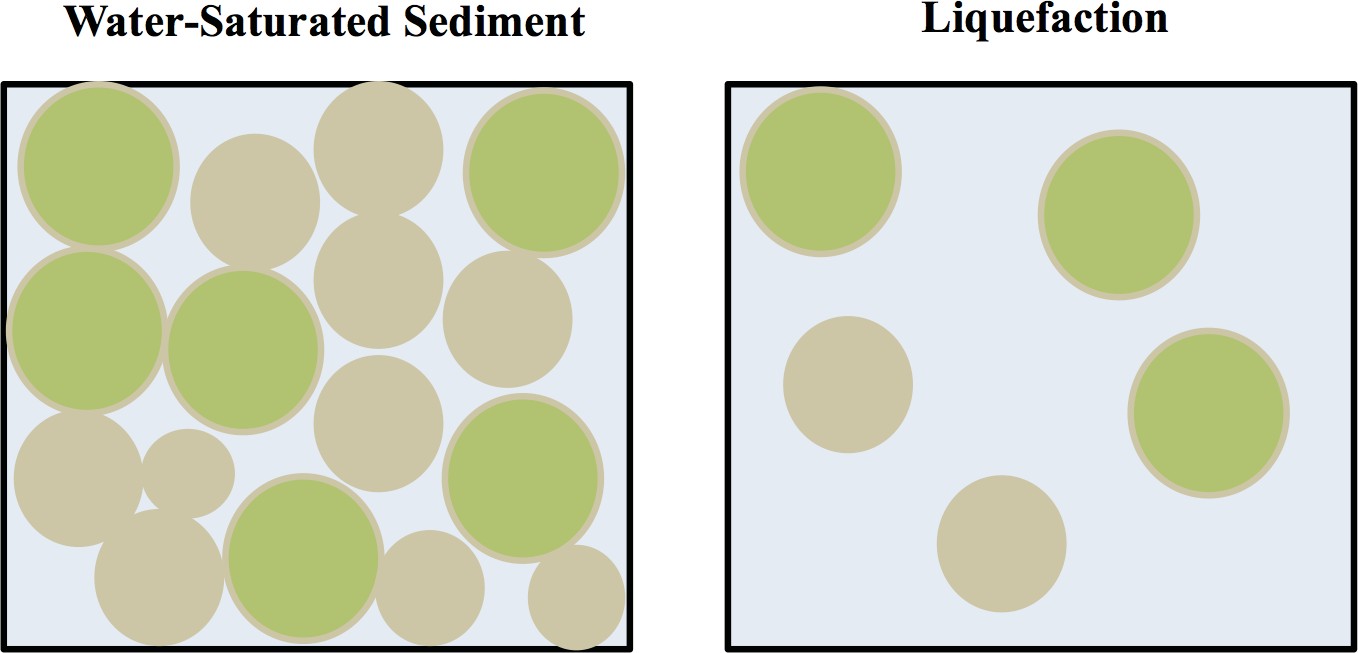
Figure 13.14 | A diagram depicting liquefaction. In the water- saturated sediment on the left, the pore (open) spaces between the grains are filled with water, but friction holds the grains together. In liquefaction, on the right, water surrounds the grains so that they no longer have contact with each other, leading them to behave as a liquid.
Author: Randa Harris Source: Original Work License: CC BY-SA 3.0
Other hazards associated with earthquakes include fire (as gas lines rupture), which may be difficult to combat as water lines may also be ruptured. The vast majority of damage during the 1906 San Francisco earthquake was due to fire. Earthquakes can trigger tsunamis, large sea waves created by the dis- placement of a large volume of water during fault movement. The Sumatra-Andaman earthquake in 2004 triggered a tsunami in the Indian Ocean that resulted in 230,000 deaths. Earthquakes can trigger landslides in mountainous areas, and initiate secondary hazards such as fires, dam breaks, chemical spills, or even nuclear disasters like the one at Fukushima Daiichi Nuclear Power Plant in Japan. Earthquake-prone areas can take steps to minimize destruction, such as implementing strong building codes, responding to the tsunami warning system, addressing poverty and social vulnerability, retrofitting existing buildings, and limiting development in hazardous zones.
13.8 INDUCED SEISMICITY
The number of significant earthquakes within the central and eastern United States has climbed sharply in recent years. During the thirty-six year period between 1973 and 2008, only 21 earthquakes with a magnitude of 3.0 or greater occurred. During the 5 year period of 2009-2013, 99 earthquakes of that size occurred within the same area, with 659 earthquakes in 2014 alone and well over 800 earthquakes in 2015 just in Oklahoma (see the blue and red line on the graph in Figure 13.15).
Human intervention is apparently the cause, resulting in induced seismicity (earthquakes caused by human activities). Humans have induced earthquakes in the past (for example, impounding reservoirs has led to earthquakes in Georgia), but this rapid increase in induced seismicity has led to much current research into the problem. Evidence points to several contributing factors, all related to types of fluid injection used by the oil industry. Hydraulic fracturing, also referred to as fracking, has been used for decades by oil and gas companies to improve well pro- duction. Fluid (usually water, though other fluids are often present) is injected at high pressure into low-permeability rocks in an effort to fracture the rock. As more fractures open up within the rock, fluid flow is enhanced and more distant fluids can be accessed, increasing the production of a well. In the past, this practice was utilized in vertical wells. With the recent advent of horizontal drilling technology, the fracking industry has really taken off. Drillers can now access thin horizontal oil and gas reservoirs over long distances, highly increasing well production in rocks that formerly were not exploited, creating a boom in US gas and oil production. While there have been many reports in the public that blame fracking for all of the increased seismicity rates, this is not entirely the case. Fracking mainly produces very minor earthquakes (less than magnitude 3), though it has been shown to produce significant earthquakes on occasion. The majority of induced earthquakes are caused by injection of wastewater deep underground. This wastewater is the byproduct of fracking, so ultimately the industry is to blame.
As wells are developed (by fracking or other processes), large amounts of waste fluid, which may contain potentially hazardous chemicals, are created. When the fluids cannot be recycled or stored in retention ponds above ground, they are injected deep underground, theoretically deep enough to not come into contact with oil reservoirs or water supplies. These wastewater wells are quite common and are con- sidered a safe option for wastewater disposal. By injecting this water in areas that contain faults, the stress conditions on the faults change as friction is reduced, which can result in movement along faults (resulting in earthquakes).
For our lab exercise, we will focus on the state of Oklahoma, and the increased seismicity there (Figure 13.16). The USGS has focused some re- search on the seismicity in Oklahoma and determined that the main seismic hazard within the state is the disposal of wastewater from the oil and gas industry by deep injection, though some smaller quakes (magnitude 0.6 to 2.9) have been shown to correlate directly to fracking. A 50% increase in earthquake rate has occurred within the state since 2013. One large earthquake of 5.7 magnitude struck in November, 2011, and has been linked to an active wastewater injection site ~200 meters away. A 4.7 magnitude earthquake struck in November 2015, too.
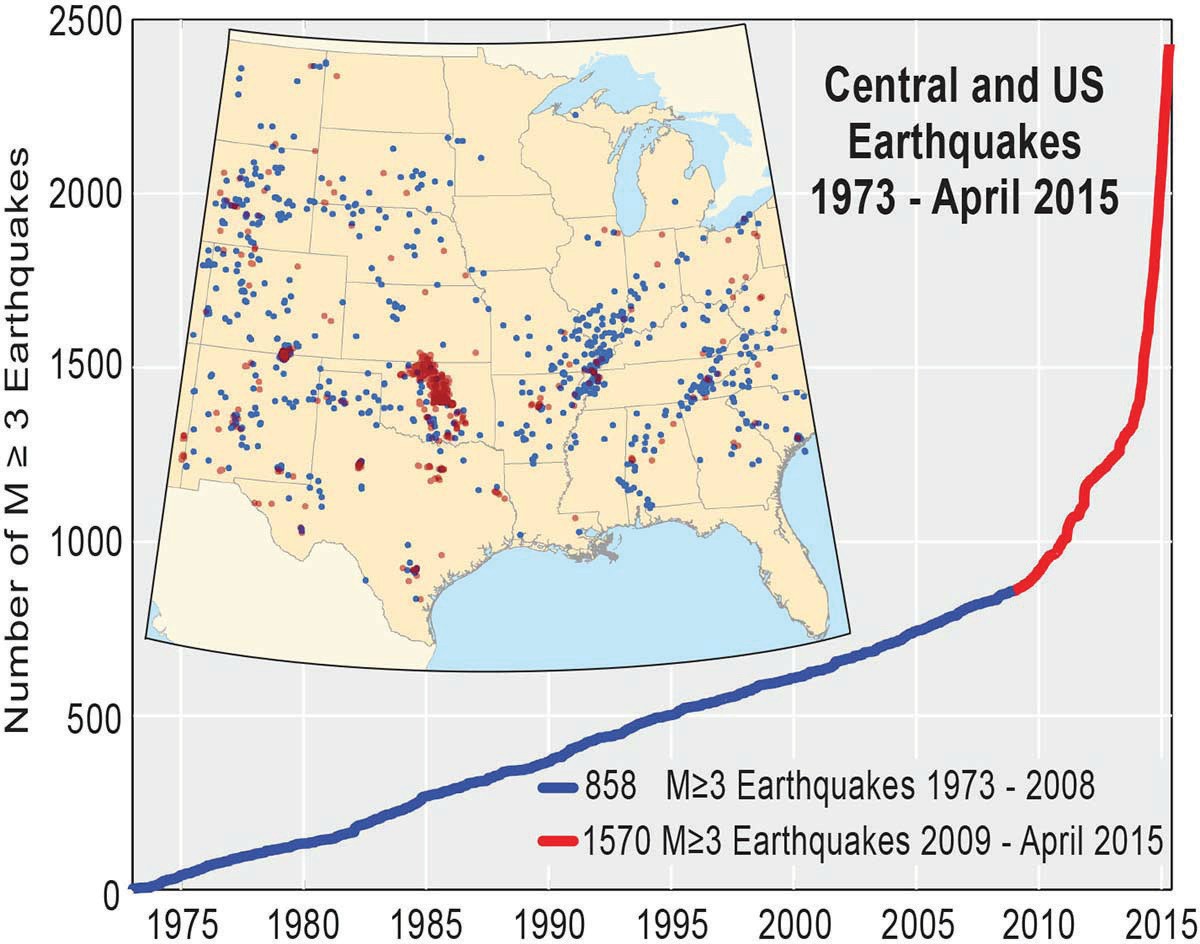
Figure 13.15 | Chart of increased seismicity of magnitude 3 or greater earthquakes within the central and eastern U.S. from 1973-2015. The spatial distribution of the earthquakes is shown on the map, with blue dots representing quakes from 1973-2008, and red dots representing quakes from 2009-2015.
Author: USGS Source: USGS License: Public Domain
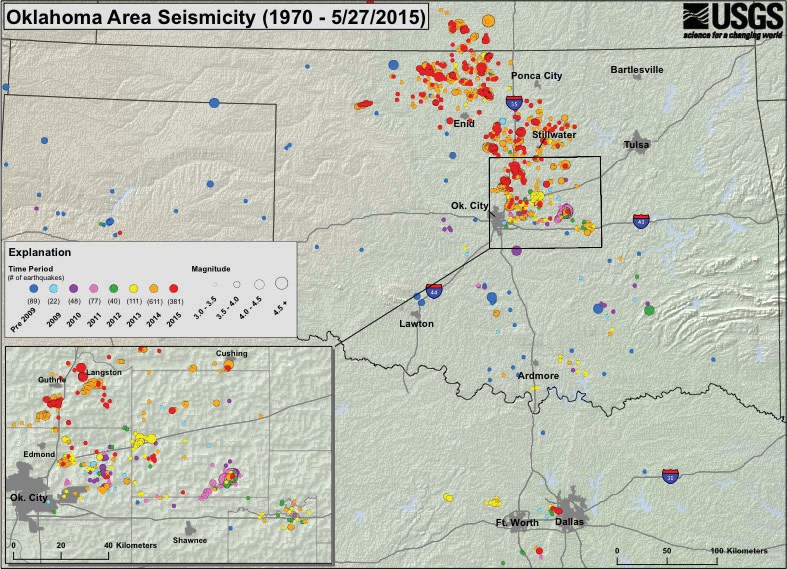
Figure 13.16 | Earthquakes that occurred within Oklahoma from 1970 – 5/27/15 are depicted above. Please note that the colors indicate year and the size indicates magnitude (see legend on image). The inset image is a close-up view of the outlined box.
Author: USGS Source: USGS License: Public Domain


Feedback/Errata